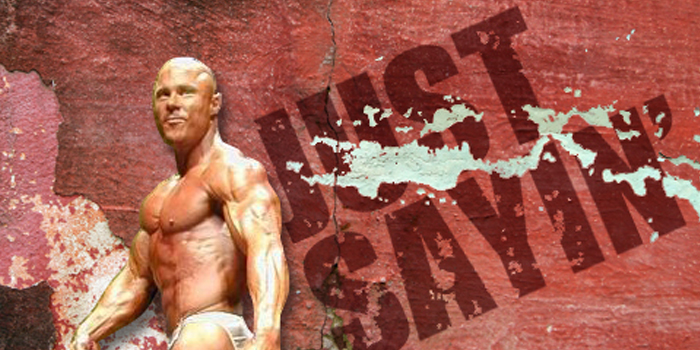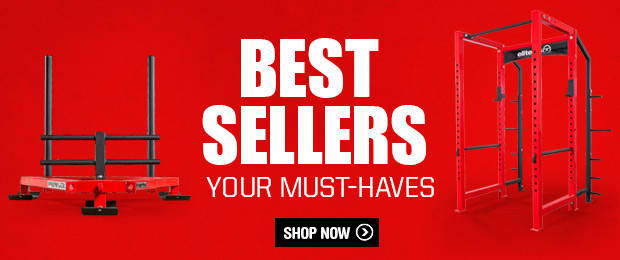
Much of what I do isn’t reinventing the wheel but rather putting things into a context that is simple and very easily understood. Because of this, I'll attempt to give you information that you might not have considered in the past. It may just make you say, “Ahhhh, I never thought of it that way. That makes total sense.” So here it goes...the number one “secret” to effective and efficient upper body training is elbow position. If you fine tune your elbow position, you'll elevate your training to another level.
I know how this works. I write something and a small percentage of you will work really hard to find holes in anything I say. For that reason, there are obviously a few exceptions. For example, abdominal crunches are an upper body exercise that would be considered an exception, as would hyperextensions or leg raises. Even with these examples, someone reading this will comment after my article about another exercise that I was too stupid to recall. Thank you ahead of time.
There are other important factors involved in effectively performing an exercise for maximum efficacy, but those things have been talked about, written about and discussed frequently. Shoulders back on the bench press? Of course. Chest high on lat pulls or chins (or pretty much any exercise that you do in the gym from legs to pecs to biceps)? All together...duh. Drive through your heels when squatting? Yawn. These are all examples that the very large majority of anyone who has trained for a few years has already learned. When was the last time someone discussed elbow position? Exactly.
RELATED: A Bodybuilder's Take on the Bands and Chains Trend
Poor elbow position not only will cut the efficacy of the exercise considerably but most times will also put you in a vulnerable position for injury. You might not be worried about injury, but all of us are usually concerned that our #gainzzz could be compromised. Below are some of the main exercises where correct elbow position is crucial.
Bench press: I'll start here considering that whether you're a powerlifter or a bodybuilder, you'll benefit from an elbow position that feeds your specific goal.
A powerlifter’s elbows will be tucked whereas a bodybuilder’s elbows will be flared. From a bodybuilding standpoint, if you ran a line through both elbows, that line should go right through your pec line. This isn't so in powerlifting. If you aren’t sure whether you're a bodybuilder or a powerlifter (hey, some of us are easily confused), ask yourself if it is more important to you to move more weight than to get larger pecs. There's your answer (and anyone who wants to argue that to get bigger, you have to get stronger can call this number: 1-800-I-dont-havethetime).
Triceps extensions (at any angle): Get this one wrong and you can really screw up the integrity of your elbows. I've seen this exercise performed incorrectly for a very long time. It would be very easy to demonstrate how to do these correctly, but I don’t have the luxury of doing that right now. I have to explain it so that you understand.
The easiest way to perform this exercise correctly is to have your upper arm slightly more than 90 degrees with the floor. I use the angle in reference to the floor because whether you're on an incline bench, standing straight up or doing flat or decline triceps extensions (it doesn't matter whether it's with dumbbells, a barbell or an EZ curl bar), the stress on the triceps will be optimal and the stress on the tendons in the elbow will be minimized greatly if the upper arm (between your shoulder and elbow) is open more than 90 degrees. For those who say that their elbows hurt when doing overhead triceps extensions, the large majority of those people hurt because of poor elbow position either currently or in the past. Notice that I said “the majority.” Some people will absolutely have elbows that hurt whether they have great elbow position or not. There are always exceptions.
Dumbbell lateral raises or upright rows: Very simply stated, the dumbbells should never be higher than the elbows during a side lateral. Proper elbow position is achieved by leading with the elbows. The dumbbells will follow. The same thing goes for upright rows. The elbows must lead, and the weight and hands will follow.
Pec deck flyes: With this exercise, the focus needs to be on the inside of the elbow (the bottom of the bicep where it attaches to the lower arm). Most people do this exercise and focus on simply bringing the hands together at the top of each rep. Instead, focus on trying to bring the inside of each elbow together. Try to touch them or get them as close together as possible. Obviously, you won't be able to, but by leading with the inside of the elbow instead of with the hands, the range of motion is increased. You'll notice the difference right away as the muscle will contract considerably harder.
MORE: 3 Old School Bodybuilding Techniques We Need to Bring Back
Biceps curls: The elbows should be back behind the body instead of in front of the body. This elbow position will shift more stress to the biceps and leave less stress on the front delts and bicep tendon. The biceps tendon attaches over the shoulder, so it's used in flexion of the shoulder. When the elbows are too far forward, you will feel the ache and discomfort in the shoulder. If you experience this pain or “ache” in the front of your delts when doing curls, this is only exacerbating the problem.
Any back movement including pullovers: Elbow position while training the back is crucial because you can get away with poor elbow position while training the back and not necessarily put yourself in a position for potential injury. However, it will limit your gains tremendously. The most important aspect of elbow position while pulling or rowing is what I call “finishing.” You need to finish the reps with the elbows behind you for a full contraction or full range of motion. So many people leave out the finished part of back reps, and their back development suffers greatly.
During dumbbell or machine pullovers, the elbows must be held closer to the head/ears instead of flared out. Keeping them close to the head transfers more stress to the muscles of the back and less to the pecs, though you won't be able to completely take the pecs out of the movement.
Elbow position is important on fly movements for the chest, front and rear laterals for delts, overhead pressing and many other exercises.
Doing the work is a relatively inconsequential part of the equation. Doing the work correctly and as efficiently as possible for your specific goals is what will have you growing and progressing as quickly as possible. And after all, isn't this game about exactly that? Just sayin'.
Skip's Coaching Log
Photos courtesy of Jeffrey Sygo at www.symiphotography.com













1 Comment